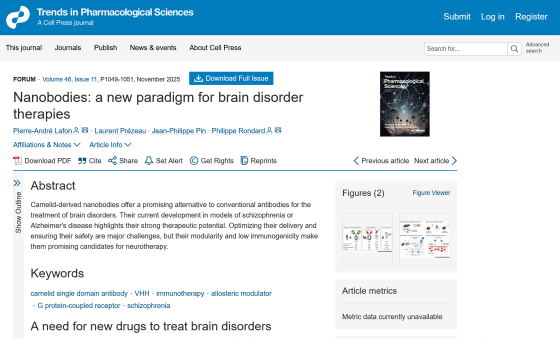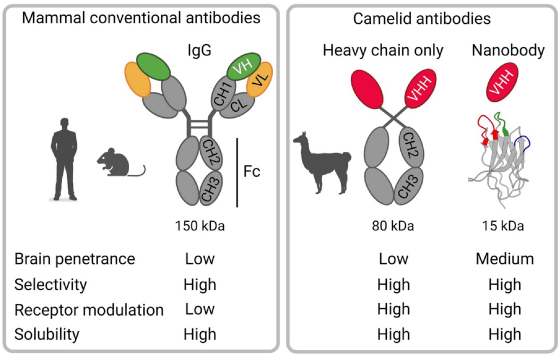Camel and llama proteins may help protect the brain from Alzheimer's disease and schizophrenia

Nanobodies: a new paradigm for brain disorder therapies: Trends in Pharmacological Sciences
https://www.cell.com/trends/pharmacological-sciences/fulltext/S0165-6147(25)00228-7

Camels and Llamas could hold the key to treating future brain disorders - Scimex
https://www.scimex.org/newsfeed/camels-and-llamas-could-hold-the-key-to-treating-future-brain-disorders
A Unique Protein in Camels And Llamas May Protect The Brain From Alzheimer's : ScienceAlert
https://www.sciencealert.com/a-unique-protein-in-camels-and-llamas-may-protect-the-brain-from-alzheimers
Antibodies bind to viruses and bacteria that enter the body and direct immune cells to eliminate or respond to them. The most common antibody in humans is called immunoglobulin G , which consists of two heavy chains and two light chains and has a molecular weight of approximately 150 kDa (kilodaltons) .
On the other hand, camelids, llamas, and other animals in the camelid family naturally produce smaller antibodies than humans, and are known to produce not only conventional antibodies consisting of two heavy chains and two light chains, but also antibodies consisting only of heavy chains. These heavy-chain-only antibodies are called 'nanobodies,' and have a molecular weight of approximately 12-15 kDa, about one-tenth the size of antibodies produced by humans.

Nanobodies are small, discreet structures that can evade and neutralize viral defense systems. Nanobodies derived from camelids have already shown promise in treating
Until now, nanobodies were thought to be ineffective in treating brain diseases such as Alzheimer's disease and schizophrenia because they were thought to be eliminated from the bloodstream by the kidneys before reaching the brain, or to be unable to cross the blood-brain barrier , which controls the transfer of substances between the blood and the brain.
However, recent studies have overcome these challenges, and animal models have shown that engineered nanobodies can cross the blood-brain barrier and target and eliminate tau and amyloid-beta proteins associated with Alzheimer's disease.

Before nanobodies can be administered to humans, scientists need to assess their stability, how they cross the blood-brain barrier, and how long they remain in the brain. They also need to develop stable, clinical-grade formulations that can withstand long-term storage and transportation.
'Camelid nanobodies open up a new era in biological treatments for brain diseases and revolutionize how we think about treatments,' said Philippe Rondard, co-author of the paper and neuropharmacologist at CNRS. 'We believe they could form a new class of drugs, somewhere between traditional antibodies and small molecules.'
Related Posts:







